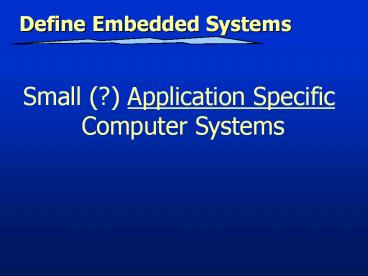Define Embedded Systems - PowerPoint PPT Presentation
Title:
Define Embedded Systems
Description:
Current day embedded systems utilize customized embedded processors ... HW co-processors: ASICs, FPGA. Storage elements: Cache, Scratchpad, SRAM, DRAM ... – PowerPoint PPT presentation
Number of Views:60
Avg rating:3.0/5.0
Title: Define Embedded Systems
1
Define Embedded Systems
Small (?) Application Specific Computer Systems
2
Typical Characteristics
- Real time
- Small sized
- Low power
- Cost effective
3
Heterogeneous HW/SW Implementations of Embedded
Systems
Additionally, flexibility and tight time to
market requirements favour SW implementations.
4
System-on-Chip Design
- Current day embedded systems utilize customized
embedded processors - Embedded processors have System-on-Chip (SoC)
architectures - SoC incorporate several different discrete cores
on the same die. - SoC design methodology strongly mirror
board-level design. - Hence, system-level hardware-software co-design
has also been utilized for SoC design. - This course will utilize platform FPGAs as a
vehicle for SoC design.
5
Control Intensive versusComputation intensive
- Control intensive application offer less
opportunities - for parallelism as opposed to computation
intensive - applications.
- Examples ???
- Hence, control intensive applications are more
- amenable for micro-controller implementation.
- Computation intensive applications are more
- amenable to custom-hardware (ASIC) or
- FPGA implementation.
6
Define Hardware-Software Codesign
It is the concurrent and co-operative design of
hardware and software components of an embedded
system.
7
HW Design Abstraction
Levels of Design Abstraction
Polygons of Silicon
8
Digital System Design
Translation or Design
Verification by Simulation
Specification
9
Traditional System-level Design Flow
Informal Specification, Constraints
System model
Architecture design
HW/SW implementation
Fail
Prototype
Test
Success
Implementation
10
Traditional System-level Design Flow
- Lack of system-level performance evaluation
- HW/SW specification implemented before
performance/energy/cost verification - Long system-level design times
- Expensive under performance/energy/cost failures
- Over-design is common
11
System-level HW-SW Co-Design
Informal Specification, Constraints
Component profiling
System model
Architecture design
Performance evaluation
HW/SW implementation
Fail
Prototype
Test
Success
Implementation
12
System-level HW-SWCo-design
IDEA
Constraints
Specification
Components (HW,SW)
System-level HW-SW Co-design
Interconnect and buses
HW behavior and components
SW behavior, RTOS, schedule policy and processors
Memory hierarchy and mapping
13
Issues in System-level HW-SW Co-design
- Specification of functionality and constraints.
- Simulation of functionality.
- Components as building blocks
- SW processors DSP and Micro-controllers
- HW co-processors ASICs, FPGA
- Storage elements Cache, Scratchpad, SRAM, DRAM
- Interconnection elements Buses and arbiters
- Interface and I/O units DMA, UART, D/A, A/D,
- Wireless communication
- Software platform RTOS and scheduling
14
Issues in System-level HW-SW Co-design
- Performance analysis (timing, power, area)
- Design and optimization (timing, power, area)
- Architecture selection processing elements,
- memory units and inter-connect.
- RTOS and schedule scheme.
15
Attributes of Embedded computing
- Real-time Operation.
- Sensing Control.
- Low cost.
- Low power consumption.
- Dependable.
- Autonomous.
16
Where Embedded Systems are Used..? 1
17
Current Accomplishments
- Current Products
- Automotive Control
- Improved fuel efficiency.
- Avionics
- Navigation, Collision avoidance.
- Medical Monitoring Systems.
- Smart Homes.(washing machines, Clocks etc.).
- Future Uses
- Intelligent Highways.
- Chemical and Biological Sensors etc.
18
An Embedded Control System Designers View
19
A Customer View
20
Specification
- A more precise description of the system
- should not imply a particular architecture
- provides input to the architecture design
process. - May include functional and non-functional
elements. - May be executable or may be in mathematical form
for proofs.
21
GPS specification
- Should include
- What is received from GPS
- map data
- user interface
- operations required to satisfy user requests
- background operations needed to keep the system
running.
22
Architecture design
- What major components go satisfying the
specification? - Hardware components
- CPUs, peripherals, etc.
- Software components
- major programs and their operations.
- Must take into account functional and
non-functional specifications.
23
GPS moving map block diagram
display
GPS receiver
search engine
renderer
database
user interface
24
GPS moving map hardware architecture
CPU
display
frame buffer
GPS receiver
memory
panel I/O
25
Processor Selection
26
Processor selection
27
Scope of Codesign
28
Steps
29
Steps Refined
30
Map between behaviour and architecture
31
(No Transcript)

